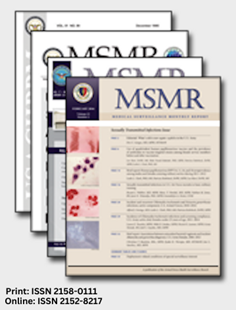Skip subpage navigation
 The Medical Surveillance Monthly Report, published continually since 1995, is a peer-reviewed journal of the Armed Forces Health Surveillance Division. The MSMR publishes monthly reports describing the incidence, distribution, impact, or trends of illness and injuries among members of the United States Armed Forces and other beneficiaries of the Military Health System. The most widely read issue each year focuses on the annual absolute and relative morbidity burden attributable to various illness and injuries among service members and beneficiaries, which appears in two issues, June and July, annually. The June 2024 and July 2024 issues are now available.
The Medical Surveillance Monthly Report, published continually since 1995, is a peer-reviewed journal of the Armed Forces Health Surveillance Division. The MSMR publishes monthly reports describing the incidence, distribution, impact, or trends of illness and injuries among members of the United States Armed Forces and other beneficiaries of the Military Health System. The most widely read issue each year focuses on the annual absolute and relative morbidity burden attributable to various illness and injuries among service members and beneficiaries, which appears in two issues, June and July, annually. The June 2024 and July 2024 issues are now available.
Articles from each issue of the MSMR are accessed by scrolling to the You Also May Be Interested In... section of this page. A printable PDF of the most recent issue of the MSMR can be downloaded here.
The MSMR is always seeking high quality, relevant submissions for publication. Prospective authors are welcome to review instructions and submit manuscripts within the aims and scope of the journal. Inquiries regarding content or material to be considered for publication should be directed to the MSMR Editor.
Here, you can download the current and past issues of the MSMR. Inquiries regarding content or material to be considered for publication should be directed to the MSMR Editor.
Citing the MSMR
When citing MSMR articles, please use the following formats:
Author Names Listed with the Article
Collier DA, Bayles MK, Barrett, JP. Acute gastroenteritis outbreak at the Armed Forces Retirement Home, Washington, DC, January 2011. MSMR. 2011;18(6):11-14.
No Author Name Listed (April 2007 to current)
Armed Forces Health Surveillance Branch. Mental disorders and mental health problems, active component, U.S. Armed Forces, January 2000 – December 2009. MSMR. 2010;17(11):6-13.
No Author Name Listed (Before April 2007)
Army Medical Surveillance Activity. Overhydration and hyponatremia among active-duty soldiers, 1997-1999. MSMR. 2000;6(3):9-11.
You also may be interested in...
Article
Apr 1, 2021
Update: Exertional Hyponatremia, Active Component, U.S. Armed Forces, 2005–2020
Article
Mar 1, 2021
A Retrospective Cohort Study of Blood Lead Levels Among Special Operations Forces Soldiers Exposed to Lead at a Firing Range in Germany
Article
Mar 1, 2021
Update: Sexually Transmitted Infections, Active Component, U.S. Armed Forces, 2012–2020
Article
Mar 1, 2021
Influenza Surveillance Trends and Influenza Vaccine Effectiveness Among Department of Defense Beneficiaries During the 2019–2020 Influenza Season
Article
Mar 1, 2021
Influenza Outbreak During Exercise Talisman Sabre, Queensland, Australia, July 2019
Article
Feb 1, 2021
Update: Malaria, U.S. Armed Forces, 2020
Article
Feb 1, 2021
Surveillance for Vector-borne Diseases Among Active and Reserve Component Service Members, U.S. Armed Forces, 2016–2020
Article
Feb 1, 2021
Historical Perspective: The Evolution of Post-exposure Prophylaxis for Vivax Malaria Since the Korean War
Article
Jan 1, 2021
Attrition Rates and Incidence of Mental Health Disorders in an Attention-Deficit/Hyperactivity Disorder (ADHD) Cohort, Active Component, U.S. Armed Forces, 2014–2018
Article
Jan 1, 2021
The Prevalence of Attention-Deficit/Hyperactivity Disorder (ADHD) and ADHD Medication Treatment in Active Component Service Members, U.S. Armed Forces, 2014–2018
Article
Jan 1, 2021
Exertional Rhabdomyolysis and Sickle Cell Trait Status in the U.S. Air Force, Jan. 2009–Dec. 2018
Article
Dec 1, 2020
Cases of Coronavirus Disease 2019 and Comorbidities Among Military Health System Beneficiaries, 1 Jan. 2020 through 30 Sept. 2020
Article
Dec 1, 2020
Characteristics of U.S. Army Beneficiary Cases of COVID-19 in Europe, 12 March 2020–17 April 2020
Article
Dec 1, 2020
Air Evacuation of Service Members for COVID-19 in U.S. Central Command and U.S. European Command From 11 March 2020 Through 30 September 2020
Article
Dec 1, 2020
SARS-CoV-2 and Influenza Coinfection in a Deployed Military Setting—Two Case Reports
You are leaving Health.mil
The appearance of hyperlinks does not constitute endorsement by the Department of Defense of non-U.S. Government sites or the information, products, or services contained therein. Although the Defense Health Agency may or may not use these sites as additional distribution channels for Department of Defense information, it does not exercise editorial control over all of the information that you may find at these locations. Such links are provided consistent with the stated purpose of this website.
You are leaving Health.mil
View the external links disclaimer.
Last Updated: July 26, 2024